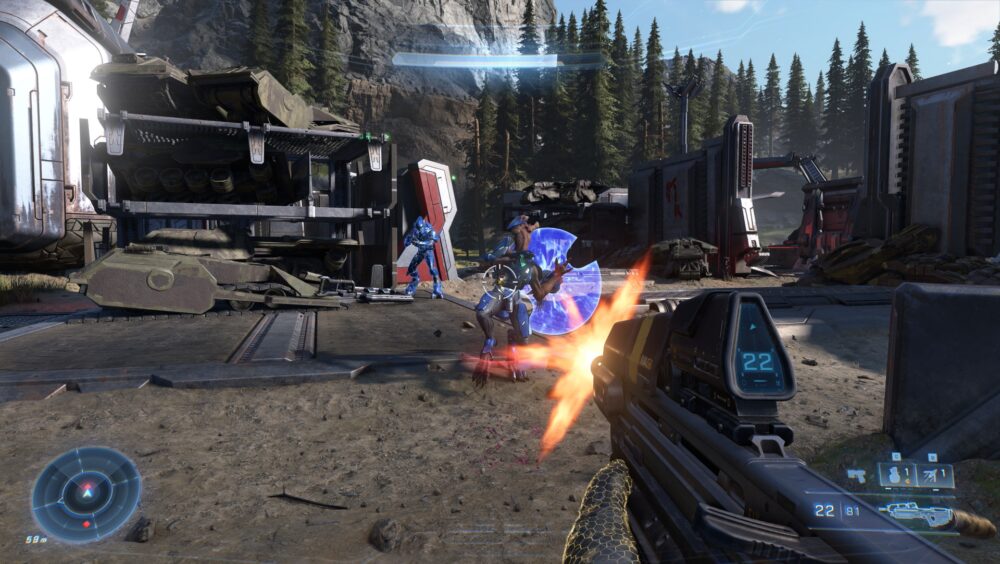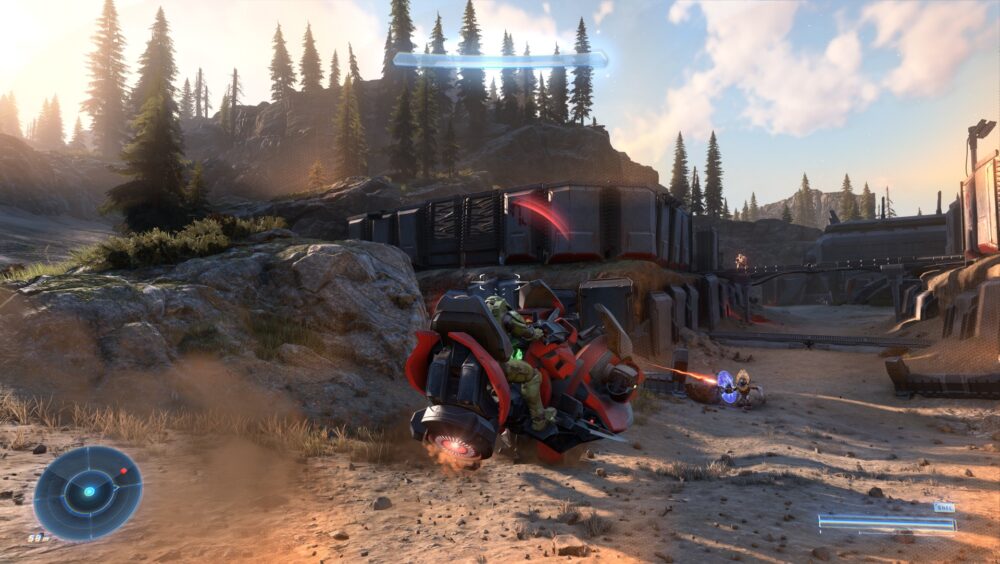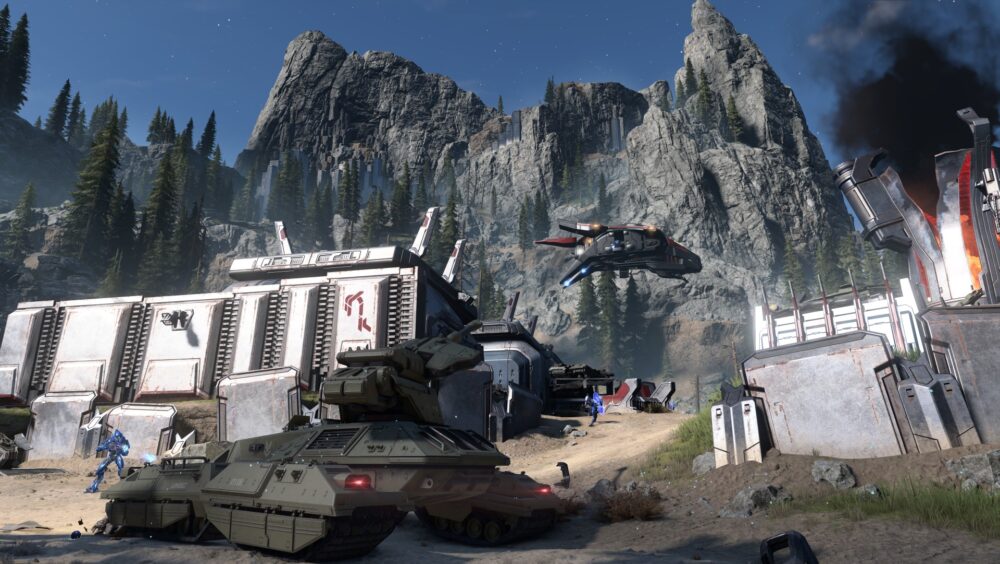Halo Infinite’s campaign is both the geographically largest Halo setting but feels the least epic. The gameplay is on point and the gunplay is as good as ever, however, while the open-world elements offer up some freeform fun at first, they do so at the expense of pacing. This doesn’t help as while Halo has always felt like an epic space-opera narrative, Halo Infinite feels like a constrained, more personal story.
Halo Infinite starts by wrapping up – or just ignoring – lingering plot threads by way of audio logs and holograms – content to tell rather than show. This is in stark contrast to the bombast and spectacle of the prior games and the fact you spend the entire game on a fragment of the Zeta Halo installation doesn’t help. Exposition dumps are used to explain the devastation and eventual capture and defeat of Cortana, which feels incredibly underwhelming in light of the build-up in Halo 4 and Halo 5: Guardians.
Despite all that’s happened, the fate of the UNSC Infinity crew is reduced to scattered audio logs and you’ll only discover the full extent of Cortana’s Mantle of Responsibility campaign against the organic races through in-game banter or more holograms. It feels lacking in comparison to the lavish cutscenes seen in the prior games.

However, if you accept the focus is no longer on a galactic war but The Chief’s personal struggles, the limited scale feels appropriate. The Chief has to come to grips with the death of Cortana and a new relationship with an AI simply known as “The Weapon” – who also happens to be responsible for trapping and destroying Cortana. Another survivor is a human pilot who reminds The Chief not everyone is a well-trained killer with no personal connections.
A lengthy cutscene reveals the remnants of the UNSC fleet arrived at the Zeta Halo and commenced an operation to capture and delete Cortana. Things go awry when a massive Banished fleet arrives and engages the UNSC’s forces in orbit. The Chief battles and falls to the Brute Chieftain Atriox and is tossed into the void for 6-months. The human pilot, Echo-216, finds him among the wrecks and brings him out of suspension. Whereas he intends to flee, The Chief aims to ensure the mission was completed. The player finally gains control the fun begins.
Unfortunately, as enjoyable as several interactions between The Chief, The Weapon, and Echo-216 are, the villains are lacklustre. It doesn’t help the plot quickly falls back on yet another terrible and unknown threat. The Banished faction leader and his underlings (who feature as sub-bosses) are all villainously evil until a few cutscenes late in the game try to give them more complexity. The true threat, a species having suffered some injustice in the past, is simply hellbent on eradicating the Forerunner’s descendants – humanity – for revenge. While I enjoyed the opening and closing hours, Halo Infinite is one of my least favourite campaigns overall.

I found the overall flow at its best during the more linear opening and closing missions – about 5-hours of a 10-ish hour campaign (if you just follow the main missions). They’re set in space ships and Forerunner structures, there are frequent narrative beats, plenty of combat, and a few boss fights thrown in. This is when Halo Infinite captures the spirit of Halo: Combat Evolved. The ship and Forerunner environments need more visual variety but they have the best pacing.
Halo Infinite retains the excellent combat the IP has always provided, irrespective of how other elements fare. Every weapon and grenade type has a purpose; recharging shields force you to play aggressively; while low ammunition reserves keep you moving and scavenging the battlefield. Priority targeting is essential, melee attacks are powerful but leave you vulnerable, and powerful vehicles provide moments of overpowered glee. Halo Infinite does its best to stop you from falling into a single playstyle. There are, of course, a few new additions that feel simple but add more tactical options. The Grappleshot allows you to zip up to ledges, grab weapons, but can also be used to hijack vehicles. The classic explosive barrel can now be picked up (also by grapple) and function as makeshift grenades.
The refined and near-perfect combat loop remains consistent and Halo Infinite offers a range of difficulty levels. Easy lets you charge into battle recklessly. Normal requires some strategy but you can usually scamper away and wait for a shield recharge if it goes wrong. Heroic – supposedly the developer-preferred experience – requires both strategy and using the best weapon. Legendary rarely allows for mistakes and several enemy types – think charging Brutes using melee attacks and Jackel snipers – will one-shot you.

At this point, we need to discuss Halo Infinite’s open-world elements. These include claiming Forward Operating Bases (fast-travel and resupply points), destroying Banished facilities, and saving Marine squads. All these activities provide “Valor” points that, at certain milestones, unlock new weapons, vehicles, and Marine support at FOBs. The Chief’s unlocks new abilities as he discovers fallen Spartans in the story missions, but there are Spartan Cores scattered around the world that provide marginal upgrades.
These systems work well together and allow for some creative sandbox entertainment. Each new Valor point milestone means something new to play with and new combat strategies. Packing heavily armoured marines in an armoured Warthog is a great way to recapture other FOBs, while the Scorpion tank and Wasp aircraft trivialise (and speed up) many encounters. The open-world spaces also highlight the usefulness of the Grappleshot in simply hauling yourself long distances.
Unfortunately, these segments offer rapidly diminishing returns, drag down the narrative pacing during the mid-game, and often don’t gel with the checkpoint and save systems. The most obvious issue is the lack of coop play at launch, despite evidence parts of the game were designed around four players. The map, though huge, is mostly empty (with annoying Far Cry 2 style respawning Banished checkpoints). Most annoying was the inconsistent way checkpointing would work during open-world activities (and even primary missions in the open world). Checkpointing at terrible moments would leave me vulnerable the moment I reloaded, while falling back on a “progress saves” (triggered after completing any objective) respawned enemy waves I had just defeated to complete the objective.

If there’s one consistent positive about the open-world sections, it’s the impressive visual and beautiful soundtrack. Sure, Halo Infinite is a cross-generation project but the results on a decent PC or Xbox Series console are impressive. The voice-acting, at least for The Chief and The Weapon AI, is fantastic – especially some terse arguments near the end-game, and you’ll eventually figure out why. It has the usual Halo issues of wild ragdoll physics for enemies and The Chief when they die but this remains entertaining rather than distracting. My biggest issue, going hand in hand with the low-key narrative, is the bland cutscenes – almost all of which are just characters talking to one another or holograms showing more dramatic events in the past.
On the whole, I enjoyed Halo Infinite’s campaign, particularly when it felt just like Halo: Combat Evolved. However, the 10 or so hours (of 20) spent ticking off open-world activities only offered brief bursts of fun before fatigue set in and I felt like I was going through the motions. As it stands, I don’t think this is the type of refresh the IP needs. A good Halo game needs good pacing, well-designed combat encounters, and epic set pieces (and some diverse environments, even if it’s set in just one location – see Halo 3: ODST).
Enjoy the review? want to read more of our reviews? then click right here to be whisked away to the realm of our opinions.








You must be logged in to post a comment.